-
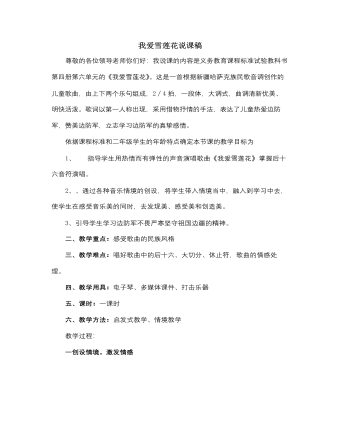
人音版小学音乐二年级下册我爱雪莲花说课稿
(意图:在这一环节中引导学生展开想象,进行小小词作家的歌词创编活动,舞创编、打击乐伴奏等活动发展学生的想象,激活学生的思维和创造力。使学生在主动参与中展现自己的个性和创造才能,体现音乐学科注重个性发展的理念)五、总结下课、情感延伸。同学们,愉快的新疆之旅就要结束了,小朋友们走进了新疆,并学唱了《我爱雪莲花》这首歌,我希望同学们你们也要象小布依拉一样,以解放军叔叔为榜样,好好学习,将来为保卫祖国,建设祖国贡献力量!大家有没有信心啊?好,同学们已经立下了誓言,我相信我们的国家一定会在你们这一代的建设下更加美丽、富饶总之通过本节课教育学使我觉得作为一名新形式下的音乐教师,不但要有扎实的基本功,还要在音乐课堂上下功夫。不断创设情境,学生一旦真正进入了音乐的意境,就会用非常自然的歌唱来赞美它,而这种自然的歌唱,是比世界上首屈 一指的小提琴还要动人心弦的。让音乐课成为学生的快乐学堂!
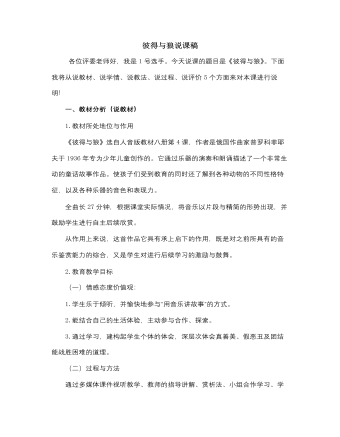
人音版小学音乐四年级下册彼得与狼说课稿
4.合作表演。(1)组内合作:组内成员合作。各组同时进行全故事的预演。(2)组外合作:组与组合作,进行分段表演,即各组分别表演某个场景,共同合作表演整个故事。设计亮点:这一环节虽是表现环节,但也是再感受、再创造的环节。它通过演的方式加深学生对音乐的理解,起到了以演代听的效果。学生参加或观看表演时,便对全曲进行了整体欣赏。这就解决了因音乐较长而学生注意力短的问题。在表现方面,注重组与组、组员之间的分工合作。四)归纳总结课外延伸同学们:《彼得与狼》交响童话,它给人们的启示是:团结就是力量,机智勇敢的去斗争,就能够战胜凶恶的敌人。这一童话故事受到世界各个地区的小朋友喜爱。因此,被制作成不同的剧目进行演绎,请同学们在课后欣赏不同剧目的《彼得与狼》。
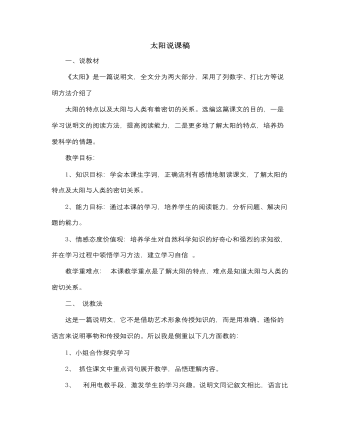
人音版小学音乐四年级下册太阳说课稿
同时,作为大班幼儿有了一定的理解语言、表达语言的基础后,往往不满足于对一首诗歌的朗诵,他们有想表达自己的想法和创编的欲望,可这种欲望要变成实践行动,需要教师的引导和支持,因此,我将“用仿《种太阳》诗歌创编活动”定位于本次活动的难点。 说教学过程:一、谈话导入,引发兴趣 小朋友,你们知道现在是什么季节吗?(春天)春天到了,农民伯伯就要播种了,把种子播到地里,等到秋天才会有所收获。现在有个小朋友也要播种,他播种的不是种子,而是愿望,他要播种什么愿望呢?我们学完这首诗歌就知道了。二、欣赏诗歌1、教师朗诵诗歌,幼儿倾听。2、提问:诗歌的名字叫什么?(老师出示教学挂图后,师生齐读题目)3、提出问题:(1)诗中的小朋友有一个什么愿望?(2)诗中的小朋友要把太阳都送给谁了,为什么?(3)诗中的小朋友为什么要播种太阳?
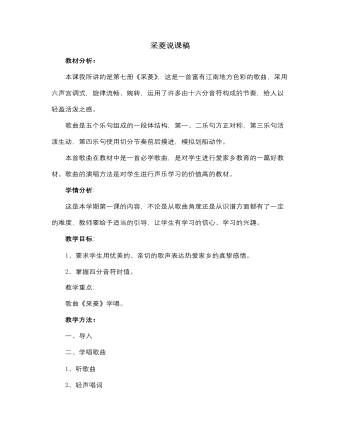
人音版小学音乐四年级下册采菱说课稿
在歌曲学习中,由于歌曲节奏疏密相间,运用了许多十六分音符构成的节奏型以及切分节奏,因此节奏是个难点。在演唱过程中,我发现学生对十六分音符和切分音符这两个节奏很难掌握,因此,我先让学生学习这两个节奏,并设计了两条节奏让学生练习,让他们拍手打节奏,使他们熟悉节奏的特点,再用到歌曲中,这样学生在学唱的时候脑子里就有了初步的印象。另外,四年级学生的识谱能力较弱,在看到旋律的时候不能一下就反应出来,尤其是这种旋律和节奏较为复杂的歌曲,所以,我尽量让学生以听范唱为主,跟着录音一起把歌曲唱好。为了解决歌曲中切分节奏,我采用请学生模仿教师拍节奏、师生对拍、接龙拍击等方式解决,在活动中适时地填入歌词(山中的清泉香喷喷;湖里的水菱甜又香),并加入小间奏边拍边读(学生容易忽视小间奏);听教师演唱学生在小间奏处拍手;最后过渡到学生听琴演唱而小间奏处用高八度音伴奏等,学生在和教师的互动中不仅学得津津有味,而且效果非常好。
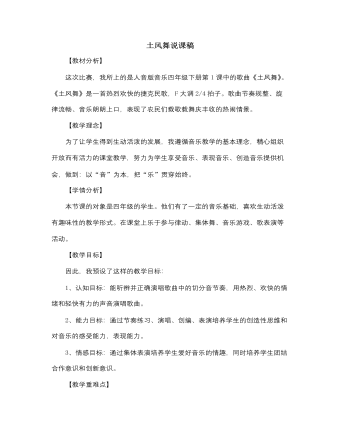
人音版小学音乐四年级下册土风舞说课稿
通过观察比较,让学生发现歌谱中的力度记号,如:重音、渐强、渐弱记号等,从而跟好的演唱歌曲,提高学生的审美能力。四、创编表演,体验情感通过视频让学生了解土风舞的舞蹈动作特点,再由小组讨论创编,为我们今天所学唱的歌曲创编出属于自己的土风舞动作。此环节的进行,让全体学生都能参与到音乐实践当中,让学生能自信地唱、大胆地编、尽情地演,感受音乐带给人们无比的快乐,学生的主体性和创造性得以充分的体现。五、总结评价,收获快乐本课的教学评价我是以表扬和鼓励为主,随时引导学生在音乐活动中开展自评互评和老师的随堂评价,以提高学生的乐感和审美能力。我评价他们的重点是能否积极自信的参与音乐表现、能否与其他的同学协作配合、在课堂小结时我还安排了学生谈一谈这节课的感想如:这节课你学到了什么?你觉得自己今天表现的怎么样?
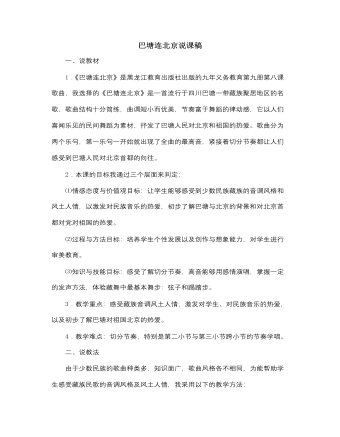
人音版小学音乐五年级下册巴塘连北京说课稿
⑷继续聆听,感受第一句把东方的彩虹比通向北京的大路。音乐的不断聆听,加深了学生对音乐的感受,只有多听,学的才能快。⑸第三遍听的时候,带领学生跳起藏族舞蹈,学生纯模仿,第一乐句跳起退踏步(为学切分奠定基础),第二乐句跳起弦子,感受巴塘弦子魅力。⑹请学生轻声模唱。⑺教师弹琴带唱,发现问题,找出演唱较好与不好的地方。⑻带领学生找出难点,特别是第二小节与第三小节跨小节切分节奏,带领学生跳退踏步,然后融入到节奏教学中。⑼跟琴熟练表演歌曲,教师提示情感的表达,德育渗透,对北京、祖国的热爱。⑽简单说明巴塘的藏族人民喜欢跳“弦子”,围成两圈,里面和外面分乐句跳弦子和踢踏步。⑾共同表演3.课外延伸与拓展介绍青藏铁路的通车,播放韩红〈天路〉,请学生用所学歌曲最后一句,创编歌词唱出你的想法。
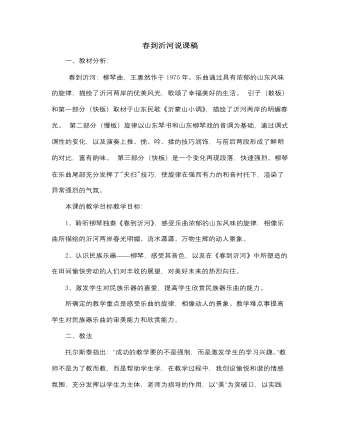
人音版小学音乐五年级下册春到沂河说课稿
欢快的音乐像小朋友在做游戏,舒缓温柔的音乐像春姑娘在翩翩起舞。这些充满童趣的语言,让他们在感受音乐中丰富了想象,在想象中又进行了乐感的培养。接着,我让学生分小组为这段旋律填写春天的歌词,这唤起并促进儿童潜在的音乐本能。让孩子们感受到音乐是自已生活中的需要。学生在一起进行创作,发挥集体协作精神,我再让小组展示自己的创作,并进行互评。这样的创作活动无论是过程还是结果,孩子们在心理上都得到满足、肯定、愉悦。最后,我采用情景陶冶法,用多媒体技术把教室创设成一个美丽的大草地,在春天图案的背景下,在优美的乐曲声中,学生分组进行游戏活动。在轻松快乐自由的氛围中学生知道了春天到底藏在哪里?它,在温暖的阳光里,在嫩绿的枝头上,在大家的歌声里,在老师的笑脸上,在我们的心里,在美好的生活里。孩子们感受到了春天的无处不在,从而更加热爱大自然。珍惜幸福生活。
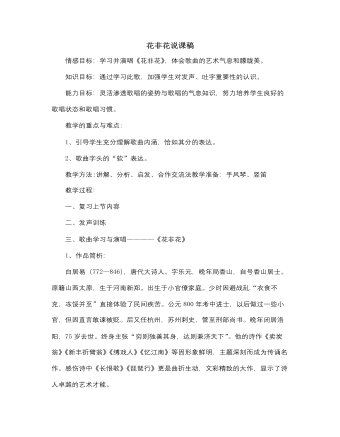
人音版小学音乐六年级下册花非花说课稿
朗读后,可请学生谈谈自己对这首诗的理解。教师还可抓住歌词中“花非花”、“ 雾非雾”和“夜半来、天明去”启发学生理解诗词所比喻的短暂易逝,难持长久的含义。5.有情感地吟诵歌词,体会词曲音调的紧密结合。可先请学生根据诗中每个字的声调,适当地放慢速度、延长韵母来吟诵,然后请一组同学吟诵一句歌词,一组同学哼唱一句旋律,其他同学对照。感知词的声调和旋律的音调之间的联系。6.学唱歌曲,表现歌曲的意境。在学唱时,教师要注意引导学生用轻柔、优美的声音来演唱。每个字的字头可唱得稍为、虚幻而柔美些,体现、朦胧诗的意境,唱好歌中的力度变化。注意气息的运用,尤其是最后一句“去似朝云无觅处”的渐慢与渐弱的处理,气息要控制好。四、拓展根据教学提示的要求,复习和交流学生已掌握的有关诗词歌曲,可以个人或设计小组演唱等多种表演形式,与同伴分享和分组展示。
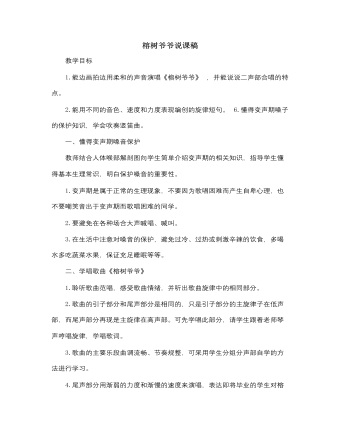
人音版小学音乐六年级下册榕树爷爷说课稿
1.能边画拍边用柔和的声音演唱《榕树爷爷》 ,并能说说二声部合唱的特点。2.能用不同的音色、速度和力度表现编创的旋律短句。 6.懂得变声期嗓子的保护知识,学会吹奏竖笛曲。一、懂得变声期嗓音保护教师结合人体喉部解剖图向学生简单介绍变声期的相关知识,指导学生懂得基本生理常识,明白保护嗓音的重要性。1.变声期是属于正常的生理现象,不要因为歌唱困难而产生自卑心理,也不要嘲笑音出于变声期而歌唱困难的同学。2.要避免在各种场合大声喊唱、喊叫。3.在生活中注意对嗓音的保护,避免过冷、过热或刺激辛辣的饮食,多喝水多吃蔬菜水果,保证充足睡眠等等。二、学唱歌曲《榕树爷爷》
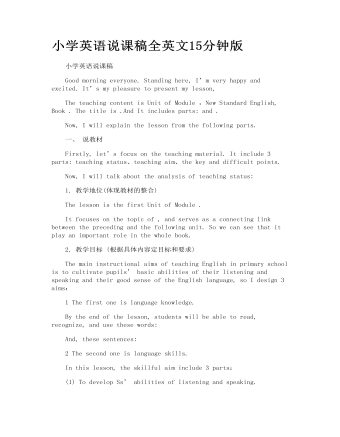
小学英语说课稿全英文15分钟版
一、 说教材 Firstly, let’s focus on theteaching material. It include 3 parts: teaching status、teachingaim、the key and difficult points. Now, I will talk about the analysis of teaching status: 1. 教学地位(体现教材的整合) The lesson is the first Unit of Module . It focuses on the topic of , and serves as a connectinglink between the preceding and the following unit. So we can see that it playan important role in the whole book. 2. 教学目标 (根据具体内容定目标和要求) The main instructional aims of teaching English inprimary school is to cultivate pupils’ basic abilitiesof their listening and speaking and their good sense of the English language,so I design 3 aims:

人教版高中英语必修1Journey Down the Mekong说课稿
2. let the Ss complete the forms paragraph by paragraph. Purpose here is to help Ss to get the habit of reading a passage as a whole, and pay attention to the organization of the text, as a result the Ss will fully understand the whole passage.3. ask Ss to retell the passage with the help of the key words in the form.Since the Ss in the class are in different levels, so I let them to fill in the blank to understand the meaning of the words and phrases better. ( That’s all for the while-reading. Now let’s move to the fifth step.)Step V: Post-reading (10mins) ---DiscussionIn this part students are asked to discuss in groups and list Wang Kun’s and Wang Wei’s attitudes about the trip. After that, Ss are encouraged to express their attitudes with the whole class. Collect their answers and don’t forget to praise them even if their answers may not be perfect.In this activity, discussion provides a vivid and active learning environment for Ss to communicate in English with newly learned language items. (Finally it comes to the homework.)StepⅥ: Homework (1min)1. Ss are required to read the text again after class and figure out the meaning of some complex sentences.2. Do the exercises on P19; This can help Ss to consolidate what they’ve learnt and make preparation for the next lessonPart4. Blackboard design.(说板书设计)On the top, there is the title of this lesson. On the left, there are main ideas for each paragraph. On the right, there are some new words and expressions.Unit 3 Travel journalJourney down the MekongMain idea of each para.:Para1: deciding to take a great bike trip along the Mekong river.Para2: Different attitudes between Wang kun and Wang wei.

人教版高中英语必修1English around the world说课稿
(3)v. 给:提出;展现,显现present sb. with sth. ; present sth. to sb. 把. . 交给;颁发;授予present sth. (for sth. )/present sth. to sb. e. g. Om his birthday, his friends presented him a collection of stamps. 在他生日时,他的朋友们送给他一套邮票作为礼物。The sword was presented by the family to the museum. 这家人把宝剑捐赠给了博物馆。The committee will present the final report to Parliament in June. 委员会将在六月向议会提交最后的报告。You need to present yourself better. 你需要更善于展现自己。It is essential that we present a united front. 至关重要的是我们要表现得更加团结。Step 4 ConsolidationT:Now that we have got a general idea of these words and phrases. Lets make up some sentences using them to master them. Suggested sentences:1. Your duties include typing letters and answering the telephone. 2. It is one of the greatest roles that she has played. 3. A large number of people have applied for the job. 4. The number of the panda is declining. 5. I'11 go there, even if I have to walk. 6. He came up to me to ask for a light. 7. The novel is about a family who can't communicate with each other. 8. He based his plan on interests of most people. 9. Why doesn't he make use of his singing talent?Step 5 Summary and homeworkT:Today we dealt with several new words and phrases. After class I hope that youcan read them again and again to keep them in mind. That's all for today. You aredismissed.

人教版高中英语必修2Computers说课稿3篇
一. 教材分析1. 本单元的中心话题是“计算机(Computers)”,内容涉及计算机的发展历史,计算机的应用等。本节课是该单元的第一课时,我将Warming up, Pre-reading and Comprehending这四部分整合为一节精读课。其中。Reading部分是题为WHO AM I?的文章,以第一人称的拟人手法介绍了计算机发长演变的历史和计算机在各个领域的应用,其主旨是表达计算机的发展变化之快以及在生活中用途之广。而Warming up部分以图片的形式展现了计算机的发展历程;Pre-reading中的问题和排序分别是为了预测语篇的内容和测试学生对计算机历史了解的情况;Comprehending则通过各项练习训练学生的阅读技能,从而加深对文章的理解。可见这几部分是一个有机的整体。2. 教学目标:1) 语言目标:重点词汇及短语:abacus, calculate, calculator, PC, laptop, PDA, robot, analytical, technological, universal, mathematical, artificial, intelligent, network, explore, in common, as a result.重点句子:a. My real father was Alan Turing, who in 1963 wrote a book to describe how computers could be made to work, and build a “universal machine” to solve any mathematical problem.

人教版高中英语必修2The Olympic Games说课稿2篇
Purpose of my design:To ask the students to do these two tasks will make the Ss predict the story of this passage. As a result, it will deepen Ss’ memory of this story because they will have their own understanding of this story.Step 3. While-readingTask 1. (Individual work _____min)Skimming: ask students to skim the text and the main ideas of each paragraph in this passage. Please read it quickly and then match the sentences with the letters.Task 2. (Individual work _____min)Scanning: read the text quickly and decide the whether the following statements are true or false and give reasons.Task 3. (Pair work _____min)Listen to the tape and fill in the banks. Then read the paragraph with expression to your partner.Task4 (individual work min)Listen to the tape again and write down the main idea in one sentence.Purpose of my design: Enable students to understand the given material better by using different reading skills. And proper competition can arouse the Ss’ interest in English learning. “Task-based” teaching method is used here todevelop the Ss’ ability of communication and also their ability of co-operation will be well trainedStep 4. Post-readingTask 1. (Individual work, pair work, group work, class work; _____min)Discussion (group of 4):1. If you were Hippomenes, would you run against Atlanta?2. Do you think Hippomenes deserved to win the race? Why or why not?Step 5. HomeworkPlease read the story again carefully after class and imagine: What will happen during the race between Hippomenes and Atlanta? Who do you think will win the race? Do you think Atlanta would marry Hippomenes? Write an end for the story with thses questions.Purpose of my design: Homework is so important and necessary for to master the knowledge they learned after class. It will check whether the Ss achieve the teaching aims.Part 5 Blackboard design

人教版高中英语必修4A taste of English Humor说课稿3篇
Then I would ask them to think of a funny English or Chinese and tell it to partners. While telling stories, they can use expressions and some acting to help make the story funny. 5 minutes would be given to do this.Those stories they told there will be the material for their writing. Soletting them tell it at first is helpful. And they can make a difference between telling a funny story and writing it down. Generally speaking, it is difficult forstudents to write well because they don’t know what to write and how to write. Asking them to tell their own stories at first can help them come up with what to write.After their telling, I would invite someone to share his/her story with all of us and I would write it down on the blackboard.This example story would be used as a sample to illustrate the format of funny story. Different from a story from teacher or textbook, a story from students can obviously become a interesting material to draw students’ attention.Then I would ask the whole class to put this story into several parts. It might be a little bit difficult for them. So I would ask them to find out whether all the sentences are necessary. After delete some sentences, there are 6 sentences left behind. Then they can easily put them into three parts. After interaction with students, I would teach them the right terms for each part and conclude the format of funny story.This step is the key and difficult point in my lesson. So I mainly usetask-based teaching method in this part and the task for students was divided into several stages. With the separated difficult level, students can find there are usually three parts in writing. They can also learn to write without the unnecessary parts in the process of analyzing. And then I wouldn’t rush to tell them the right terms to them directly. Instead, I would ask them to name them by their own. A confused mind is better for acquiring knowledge.While-writing:Then I would give students 7 minutes to write down this story, without other requirements.With all the preparations in pre-writing, students’ difficulties were cleared. So it would be much easier for them to write down the story within 7 minutes. There are no other requirements because students’ first writing is actually a drafting. It would be revise and edit several times later. Writing, as a skill

人教版高中英语必修3Festivals around the World说课稿3篇
Teaching plan for Unit 1 book3Good morning, teachers. It’s my great pleasure to be here because I can share my lesson with you and I can learn a lot from it. I’ll begin my lesson from the following four parts, the teaching material, the teaching methods, the studying methods and the teaching procedure.Firstly, let me talk about the teaching material. The content of my lesson is the reading passage festivals and celebrations of Unit 1 Festivals around the world. This passage is about festivals and celebrations. By studying this passage, we’ll enable the students to know that festivals exit everywhere, and many of festivals in different countries celebrate similar ideas. As we all know, the reading passage is the center of each unit. If the Ss can learn it well, it will be helpful to make the Ss learn the rest of this unit.After studying the teaching material, I think the teaching aims are as the followings:1. Knowledge aims:(1) The Ss can master the usage of the important words andexpressions.(2)The Ss can use the __________________ (grammar) in the proper situation.Make students know about the festivals all over the world and the detail of the festivals, such as origin, content, and the date of the holiday festivals.2. Ability aims:(1) Students can talk about festivals and celebrations in English(2) To improve the student’s reading ability, especially their skimming and scanning ability.3. Emotion aims:Make the Ss know about the foreign festivals, and respect other countries’ custom.Next, let’s come to the important points and the difficult points.The important point is how to make the Ss understand the text better and the difficult point is how can they talk about it. secondly, Teaching Methods:1. task-based Language Teaching2. Computer assisted language teaching.3. question-and–answer methodThirdly, Studying Methods:

人教版高中英语必修4Working The Land说课稿3篇
Knowledge objectives:(1) to make Ss grasp the usage of words, expressions and sentence structures: statistics, struggle, thanks to, rid of, some patterns for persuasion, the “ing” form as subject and object;(2)to use learnt knowledge to persuade sb.Ability objectives:(1) to develop Ss’ reading skills(skimming, scanning, word guessing);(2) to improve Ss’ speaking, communicating and cooperating skills.Emotional objectives:to make Ss know the contribution of Yuan,and learn his spirit and his simple life time.Teaching important and difficult points:(1) some words, expressions and sentence structures mentioned above;(2)the content of the text;(3)training their reading and speaking skills.Teaching methods: CLT, TBLT,QT.Learning strategies: CLS, QLS, TBLS.Teaching procedures:Step 1 lead-in: (1) teacher plays a piece of recent news from CCTV about the harvest of the super hybrid rice, and ask students whether they know Yuan or not, and talk about him and his contribution.(2)Brain storm: let Ss describe Yuan in their minds including his appearance, his living condition and so on.Step 2 fast reading tasks:(1)teacher introduces Yuan and super hybrid rice(2)make Ss read the text as fast as possible with questions. Such as: what’s the general ideaof this passage? What’s Yuan’ dream? (skimming and scanning skill)Step 3 intensive reading tasks(1)let Ss read the text silently, find topic sentence of each paragraph and draw the difficult sentences and the knowledge what they don’t understand.(words guessing)(2)teacher and Ss talk about the important words, expressions and sentences together, and ask Ss to retell the content of the text.(summarizing and paraphrasing)(3)teacher summarize this part.(4) read again following the courseware.

人教版高中英语必修5Great scientists说课稿4篇
通过写文章梗概,培养学生综合运用语言的能力,学习用恰当的英语描述科学家的故事。这是本课的教学难点。教师可以使用完形填空的方式来帮助学生整理语篇,从而来降低难度。本课的教学重点的突破方法是:在阅读前,让学生初步了解得出科学观点所需要的基本程序,从而轻松而自然地导入文章的阅读;在阅读过程中,由易到难设计快速阅读和精读的问题,层层推进各种阅读活动,让学生对阅读内容从整体感知到细节理解,最后深层读懂整篇文章,同时加强阅读策略的指导,让每个学生都主动参与课堂教学活动,最终达到提高阅读能力的目的。Step 4 Post-readingGroup Activities四人小组共同合作,在老师的适当指导下,就以下2个问题展开讨论,让学生就所知、所学、所感和所想融入话题,然后抽若干同学代表作小组发言。1. What do you think about John Snow, and what should we learn from him?2. Cholera was 19th century disease, which two diseases are similar to cholera today? Why?

人教版高中英语必修5The United Kingdom说课稿4篇
Teaching Aims:Knowledge 1. Get the students to learn the useful new words and expressions in this section. Aims:2. Let the students learn about how the UK was formed and the four groups of invaders.1. Develop students’ reading ability and let them learn different Ability reading skills. Aims:2. Enable students to learn to talk about the United Kingdom and the Union Jack Emotional 1. Let students know more about the UK2. Develop students’ sense of cooperative learning Aims:Teaching Important Points:1. Let the students learn about the countries of the United Kingdom and the Union Jack2. Get the students to read the passage and know about how the UK was formed and the four groups of invaders.3. Have the students learn different reading skills.Teaching Difficult Ponts:1. Develop students’ reading ability.2. Enable students to talk about the United Kingdom and the Union Jack.3. Let students learn how the UK was formed geographically and historically.Teaching Methods:Showing pictures, asking, exercising, listening, reading etc.Teaching Aids:A computer,a projector and a blackboard.Teaching Procedures: 1) Show a map of the world, ask students the following questions:Where is the UK?What’s the full name of the UK?2) Ask the students work in pairs to do the quiz on Page 9.Do you want to test how many things you know about the United Kingdom? Let’s have a small test.Using the map on P9, students answer the following questions:?How many countries does the UK consist of? What are they??England is divided into three main areas. Do you know what they are? 1) Scanning (10Minutes )Let the students hold the questions asked in pre-reading and read the passagequickly and then let them do the following exercise.Join lines to the right answer.

人教版高中英语必修4Body Language说课稿4篇
Textbook: Senior English for China (Book 4), by Liu Daoyi Time Allotment: 1 period (40 minutes)Date: March 20, 2014Teaching aids: blackboard, Multi-media, Power Point, chalk I. Text Analysis (教材分析)This unit is about body language, and the text selected in the reading part demonstrates the difference and similarity of body language in many parts of the world. Through learning this passage, students are required to raise their awareness of using body language in different parts of the world. As body language is closely related to our daily life, it is easy to arouse students’ interest in learning this text. Reading skills and speaking training are designed around the text.II. Teaching Objectives (教学目标)By the end of the lesson, students will be able to:1. Language Skill Objective(语言技能目标): develop reading ability (skimming and scanning)as well as speaking ability.2. Cultural Knowledge Objective(文化知识目标): know about the cultural differences of using body language.3. Affective Objective(情感目标): increase students’ awareness of using body language correctly in different cultures. III.Teaching Focuses and Difficulties(教学重点和难点)1. Teaching Focuses(教学重点): the difference and similarity of body language in many parts of the world.2. Teaching Difficulties(教学难点): develop students’ reading abilities of skimming and scanning and ask the students to show their opinions with fluent English.